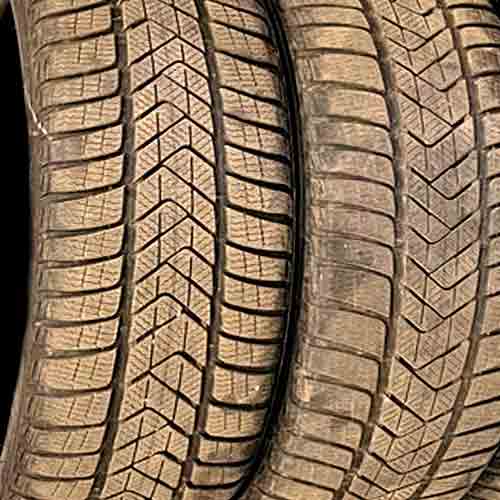Both Pirelli P Zero Winter and SottoZero 3, renowned for their performance in winter driving, are set to battle it out. Let’s see which out of them, is a better fit for your needs.

Table of Contents
Dry Traction
Dry grip is contingent upon the tire’s contact with the ground, and here, there are two key elements which contribute the most, directional grip and lateral traction.
The Pirelli SottoZero 3 excels in directional grip by virtue of its continuous running rib at the center, as this design ensures a more consistent connection with the road surface during straight-line travel, resulting in shorter braking distances and acceleration times.
Same is the case when it comes to handling, the tire offers superior traction with it’s lighter weight, and less susceptible to bending tread.
So it’s blocks don’t causes as much of the over and understeering, compared to P Zero Winter.
Review this tire in greater detail: https://snowytires.com/pirelli-winter-sottozero-3-review/
Snow Performance
In the realm of snowy conditions, both tires exhibit commendable performance, showcasing their competitiveness.

However, looking at the test results, it becomes evident that the Pirelli P Zero Winter outshines its counterpart in terms of traction, particularly on slightly fluffy terrains.
But why is that the case? Well, a closer inspection of its tread reveals the reasoning behind this advantage.
The Pirelli P Zero Winter basically features an asymmetric tread pattern, featuring lugs with a more open design that facilitates enhanced contact between the snow and the tire surface.
The interlocking grooves and snow-vices adeptly gather the fluffy snow, effectively trapping it within the tread.
This unique feature enables the tire to maintain consistent contact with the ground, thanks to the lodged snow serving as a medium for increased traction.
The adherence of snow to snowflakes proves more effective than its adhesion to rubber, resulting in superior performance.
In contrast, the Pirelli SottoZero 3 exhibits a more closed structure, with a continuous running rib at the center and a lack of interlocking groove configuration. Consequently, its tread is unable to gather as much snow as its competitor, diminishing its traction capabilities.
Wet Traction
Wet traction depends on two primary factors: tread design and rubber compound, and here the Pirelli SottoZero 3 holds the advantage.
Its tread incorporates a multitude of rectilinear and interlocking sipes, which effectively absorb water particles that come into contact with the tire.
On the other hand, the Pirelli P Zero Winter only features rectilinear siping, so it’s wet grip isn’t so commendable, though the tire does offer superior resistance to hydroplaning, I can give you that.
Testing reveals its slightly higher speeds on both curved and straight aqua tests.
This improved performance can be attributed to the interconnected web of grooves on the tire’s tread, which disperses water in all directions, more effectively.
Ice Performance
When tested in icy conditions, the Pirelli SottoZero 3 emerges as the superior choice, impressively showcasing a shorter average braking distance compared to its counterpart.
(On average, it comes to a stop ten feet earlier).
This tire basically offers a better design of biters, which are interlocked with each other, forming V-shaped notches facing both lateral directions, combined with more aggressive siping.
These design elements provide much better gripping, when snow is more packed up, (in the form of ice).
In comparison, the Pirelli P Zero Winter takes a back seat with its larger tread voids and fewer notches, despite it having an aggressive asymmetric tread pattern.
The tire basically lacks interlocking sipes, and that hinders it’s overall ice performance the most.
Comfort Levels
Comfort in a tire encompasses factors such as road noise and vibration absorption. Both of these dimensions are influenced by various aspects including tire’s construction, materials used, and tread pattern.
Having said that, to simply things, in terms of tread noise, the Pirelli SottoZero 3 offers slightly better performance due to its less voided tread design. This design reduces the occurrence of air particles hitting the tread walls, a major source of noise.
Conversely, the Pirelli P Zero Winter provides slightly better cushioning against bumps, enhancing overall comfort. Thus, it can be concluded that both tires offer comparable comfort levels.
Fuel Economy
Fuel consumption is influenced by a tire’s adherence to the road surface and its structural weight. In this regard, the Pirelli P Zero Winter suffers from its stickiness to the road and its relatively broader tread voids, leading to increased rolling resistance and friction as the tire moves along the pavement.
However, it should be noted that the tire exhibits significantly improved performance in extreme winter temperatures.
In contrast, the Pirelli SottoZero 3’s lighter weight and longitudinally aligned ribs facilitate better streamlining compared to the asymmetric pattern of its counterpart.
This design optimizes fuel efficiency during straight-line travel, such as on highways, by minimizing energy expenditure.
Tread Life
Tread longevity is also influenced by rolling resistance, in which the Pirelli SottoZero 3 outperforms its competition once again.
The tire’s lighter weight reduces the force exerted by its blocks on the road surface, resulting in less friction and a slower overall rate of rubber wear.
Conversely, the Pirelli P Zero Winter carries more weight and distributes this additional load on a smaller rubber surface due to its wider tread voids.
Consequently, each lug bears more weight pressure, leading to accelerated tread wear and a shorter lifespan.
Nevertheless, it is worth noting that the performance difference between the two tires in terms of tread life is not substantial, and both tires do not offer any (treadwear) warranties.
Summing Up
In summary, the Pirelli P Zero Winter excels in fluffy snowy terrains, while the Pirelli SottoZero 3 outperforms its counterpart on packed snow and ice, demonstrating shorter braking distances and handling times.
On paved surfaces, the Pirelli SottoZero 3 maintains the upper hand in both wet and dry conditions, although the Pirelli P Zero Winter showcases superior hydroplaning resistance.
Apart form that, both tires provide excellent overall ride comfort, with the Pirelli SottoZero 3 offering a quieter ride and its counterpart delivering superior bump absorption.